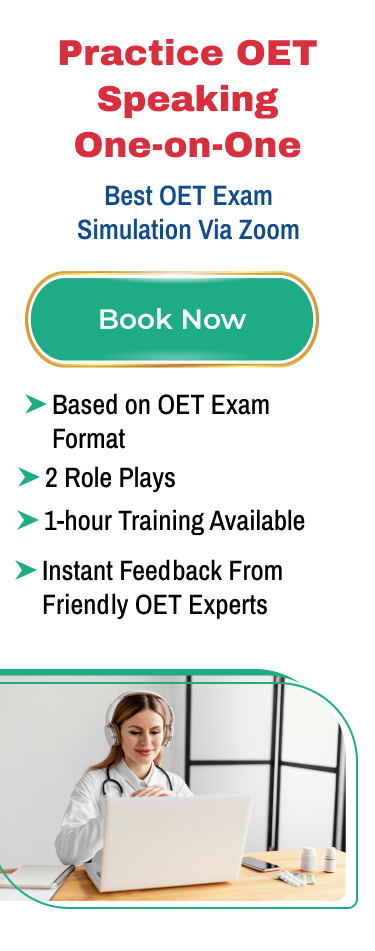Understanding OET Speaking Assessment Criteria
- 5 Comments


Most reputable tests or exams will provide evaluation rubrics that tell you what is expected and how your performance will be assessed. The OET Speaking sub-test provides these rubrics as well and we are going to explain these to you so that you understand what examiners are looking for. Bear in mind that in the OET Speaking sub-test, it is a test of communication skills, as much as it is a test of grammar and medical knowledge.
Table of Contents
When examiners evaluate your OET Speaking performance, they will essentially look at the TWO main criteria for marking and these are the:
- LINGUISTIC criteria
- CLINICAL COMMUNICATION criteria
The four elements involved here are
- intelligibility
- fluency
- appropriateness of language and
- resources of grammar and expression
Intelligibility
means whether the examiner can understand what you are saying. This includes whether your voice is clear and if you are pronouncing your words correctly. You should not speak too fast or too slowly but should maintain a natural rhythm. Word stress and intonation are also important. In general, the examiner should not be straining to try and understand what you are saying.
Fluency
refers to the smoothness of your speech. It means that you do not pause for too long while searching for the right words to get your message across. You should avoid the excessive use of fillers such as ‘ah’, ‘um’, ‘ok’ and ‘er’ because these impede fluency.
Appropriateness of language
is all about using language that is suitable to your listener. Yes, you are the medical professional, but that does not mean that you can use all the medical jargon you know when you are communicating with a patient or a patient’s next-of-kin. This is because your listener may not be familiar with the medical terminology that you use. Even if you do not say anything wrong at all, if your listener does not understand what you are saying, that means that you have failed to communicate with the patient or the patient’s next-of-kin. Tone of voice is included in appropriateness of language. This is of extreme importance and you will need to adopt the correct tone (and volume) when delivering different messages, especially sensitive information or bad news.
Resourcefulness of grammar and expression is
about your range of vocabulary. It includes being able to paraphrase when necessary. In fact, paraphrasing is an essential skill especially when doing a ‘repeat back’ (i.e., repeating what the patient or patient’s next-of-kin has told you in order to check that you have understood them correctly). It is also about understanding the use of idiomatic expressions and even being able to use these expressions appropriately.
You will use all your linguistic abilities (as discussed in the section above – linguistic criteria) to fulfil the clinical communication criteria. There are five elements in the clinical communication criteria and these are
- indicators or relationship building
- indicators of understanding and incorporating the patient’s perspective
- indicators of providing structure
- indicators of information gathering
- indicators of information giving
Indicators or relationship building
show that you are interested in building a good professional relationship with your patient or the patient’s next-of-kin and that you are not there to just merely impart information. To this end, greetings are essential. For instance, a friendly, “Good morning John! How are we feeling today?” is important when greeting a patient in a hospital ward. It is also important to introduce yourself and let the patient know the purpose of your communication. Throughout your exchange, you will need to adopt the right tone that is always respectful and non-judgmental. Due to the nature of the healthcare setting, it is also crucial that you empathise with your patient. Be very careful that empathy does not lead you to offer or promise something that goes against professional policy, though. For instance, if a patient complains about hospital food, you can emphathise with the patient and offer some suggestions within the constraints of hospital policy BUT you should never allow the patient to bring in unauthorised food if it is against the hospital rules. Bear in mind that attentiveness is also important as part of relationship building. You need to show an interest in what the patient is saying.
Indicators of understanding and incorporating the patient’s perspective
show that you have elicited from the patient. This includes obtaining the facts of the case as well as the patient’s ideas, concerns and expectations. You will need to listen actively to what the patient is telling you because you will need to relate your explanations to the patient based on what information you have acquired from the patient in the first place. It is therefore good to do a ‘repeat back’ to the patient so that you can check that you have understood what the patient has said. Bear in mind that you are also expected to pick up on the patient’s cues such as hints, pauses, hesitations and change in volume. This is an important element of the exchange because some patients are hesitant to express what they feel in a clinical setting.
Indicators of providing structure
include taking charge of the exchange of directing the conversation purposefully and meaningfully. Remember, you are the healthcare professional and you are expected to be in charge of the conversation. Signposting is useful in providing structure, so appropriate linguistic resources should be used. For instance, you can say, “So, first I will explain to you about….then, I will show you how to… and at the end, if you have any questions, you can….”. This is done to let your listener know that this is where the conversation will be heading today. Another important thing you need to know is that repetitions are sometimes necessary to drive home an important point. You can repeat some parts of the interaction or you can paraphrase them. Using adverb intensifiers to emphasise a point is also expected. For instance, instead of saying, “You need to do this exercise carefully at home”, you can say, “You need to do this exercise extremely carefully at home”.
Indicators of information gathering
show that you are skilled in obtaining information. Remember, not everyone will be forthcoming in giving you information. You will need to utilise active listening techniques and minimise interruptions when the patient is speaking. You should use open questions in the beginning, rather than closed questions (i.e., questions with ‘yes’ or ‘no’ answers). For instance, if you ask, ‘Are you feeling unwell today?’, the answer can only be ‘Yes’ or ‘No’. Instead, if you say, “What seems to be bothering you today?”, you will elicit more from the patient. You can move on to closed questions when you progress further in your interaction with the patient, especially when you are checking comprehension, but you should NEVER use leading questions. Leading questions are like you putting words in the patient’s mouth. Apart from that, you are expected to be able to clarify vague statements to make sure that you have understood the patient correctly. You should also be able to summarise what the patient has told you. The ‘repeat back’ strategy is a good way of doing this.
Indicators of information
giving show that you are able to convey your message appropriately to the patient as well. Communication is a two-way street and you not only need to gather information from the patient, but you will also need to give the patient information as well. You have to establish what the patient already knows, and encourage the patient to contribute reactions or feelings. The patient’s reactions need to be responded to appropriately and used to guide your next steps at times. Apart from that, you will need to periodically check whether the patient has understood you. In addition, you must not think that you have delivered all the necessary information once you have said all you want to say. You should instead always try to discover if the patient needs further information.
These speaking evaluation criteria may seem like a lot but they are actually quite easy to master once you are familiar with them. They are aspects which a medical professional is reasonably expected to master because these are practical skills which will be needed when you work in this field. Find someone who is familiar with all these criteria to practise the OET Speaking sub-test with. After a few practices, you will find your confidence level increasing and soon, it will come naturally to you. If you need help with Speaking practice, you can check out the Benchmark Speaking Practice Service here. We provide real-time feedback so that you can practise simulated OET Speaking sub-test questions with an OET expert.













which skill (linguistics or clinical communication) weigh more? what percentage of score do each of them carry?
Linguistic – 4 criteria (max 6 marks)
Clinical comm – 5 criteria (max 3 marks)
No clear guidelines on percentage/ratio
20:38 means what’s the score
During speaking role play.. After examining patient.. (Oh my God it’s really big..) Can we say like this? Will the assessors reduce our score?
How many do I need out of 39 criteria score to get B in speaking?